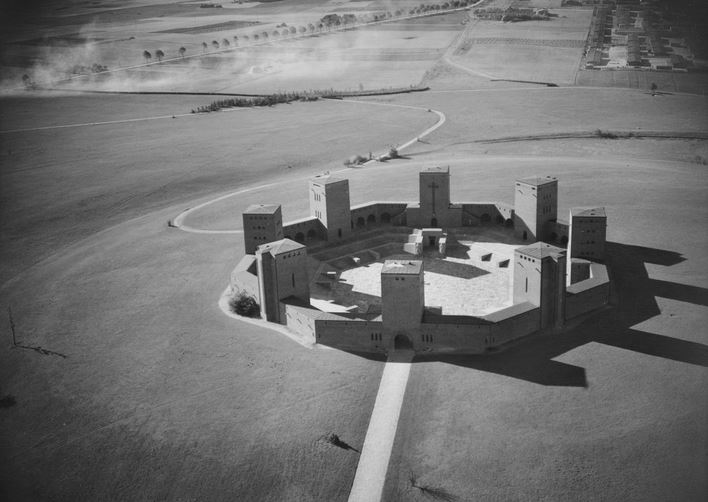W roku 1927 niedaleko miejscowości Hohenstein (obecnie – Olsztynek) stanął olbrzymi monument mający upamiętniać niemieckie zwycięstwo w tak zwanej Drugiej Bitwie pod Tannenbergiem, która w propagandzie Niemiec miała być rewanżem za przegraną w pobliżu bitwę pod Grunwaldem w 1410 roku 😊.
Pomnik nierozerwalnie związany był z postacią Paula von Hindenburga. Był on dowódcą w zwycięskiej dla Niemców bitwie w sierpniu 1914 roku. Dzięki temu uznany został za męża opatrznościowego i obrońcę Prus, co pozwoliło mu potem przekuć sukces wojskowy w polityczny. To on jako ostatni prezydent Republiki Weimarskiej przekazał władzę Hitlerowi. Po jego śmierci w roku 1934 do jednej z wież złożono jego ciało, przez co budowla zyskała miano Mauzoleum Hindenburga. Z całych Niemiec organizowano wycieczki do tego miejsca – którego odwiedzenie stało się niemal obowiązkowego dla każdego młodego nazisty.
Architektonicznie mauzoleum nawiązywało do kamiennego kręgu w Stonehenge.
Ale co to ma wspólnego z Warszawą?
Dwadzieścia osiem lat po ceremonii pogrzebowej marszałka, przedstawiciele „władzy ludowej” odsłonili znacznie skromniejszy pomnik przy ulicy Smolnej. Oficjalnie pomnik nosił nazwę „Pomnik Bojowników o Polskę Ludową i Pomnik Partyzanta Gwardii Ludowej”. W skrócie nazywano go „Pomnikiem Partyzanta”, a warszawska ulica, po swojemu przekorna, szybko ochrzciła go „Pomnikiem pijaka”.
I teraz połączmy historię pomników.
W styczniu 1945 roku Niemcom w ostatniej chwili udało się wywieźć trumnę ze zwłokami marszałka, a pomnik – mauzoleum wysadzono w powietrze. W roku 1949 rozpoczęto ostateczną rozbiórkę ruin.
Część granitowych płyt przetransportowano do Warszawy, gdzie użyto ich, między innymi, do budowy schodów pomiędzy poziomem ulicy a parterem gmachu KC PZPR (obecnie Centrum Bankowo-Finansowe „Nowy Świat”) oraz cokołu „Pomnika Partyzanta”.
Źródło: Arkadiusz Żołnierczyk; Gazeta Wyborcza, Wikipedia
In 1927, near town of Hohenstein (now – Olsztynek in Mazury Region), a giant monument was erected to commemorate the German victory in the so-called Second Battle of Tannenberg, which in German propaganda was supposed to be a rematch for the defeat at the Battle of Grunwald in 1410 😊.
The monument was inseparably connected with the figure of Paul von Hindenburg. He was a commander in the victorious for Germans battle in August 1914. Thanks to this, he became recognized as a providential husband and protector of East Prussia, which allowed him to transform military success into a political one. He was the last president of the Weimar Republic who gave power to Hitler. After his death in 1934, his body was put into one of the towers, which meant that the building started to be called the Hindenburg Mausoleum. Trips to this place were organized from all over Germany – the visit of which was almost compulsory for every young Nazi.
Architecturally, the mausoleum referred to the stone circle at Stonehenge.
But what does this have to do with Warsaw?
Twenty-eight years after the Marshal’s funeral ceremony, representatives of the „People’s Government” unveiled a much more modest monument at Smolna Street. Officially, the monument was called „Monument of Fighters for People’s Poland and Monument to the Partisan of the People’s Guard.” In short, it was called the „Monument to the Partisan”, and the Warsaw street, in its contradictory style, quickly baptized it with the „Monument to a drunkard”.
And now let’s combine the history of monuments.
In January 1945, the Germans managed to take away the coffin at the last minute with the body of the marshal, and the monument – the mausoleum was blown up. In 1949, the final demolition of the ruins began.
Part of the granite slabs were transported to Warsaw, where they were used, among others, for the construction of stairs between the street level and the ground floor of the PZPR Central Committee building (Now Centrum Bankowo-Finansowe „Nowy Świat”) and the plinth of the „Partisan’s Monument”.
Source: Arkadiusz Żołnierczyk; Gazeta Wyborcza, Wikipedia

